Are you a Quiet Speculation member?
If not, now is a perfect time to join up! Our powerful tools, breaking-news analysis, and exclusive Discord channel will make sure you stay up to date and ahead of the curve.
I have a confession to make. This isn’t easy to say because I know it’s going to trigger numerous readers. Some may even go as far as to unfollow me on Twitter for sharing this unpopular opinion.
My name is Sig, and I like the Reserved List.
Clearly I’m in the significant minority on this matter; at least, I am in the minority amongst the MTG community most vocal on Twitter. But even Saffron Olive’s recent Twitter poll, which earned over 13,000 votes (surely this is statistically significant), indicates that my opinion is matched only by about 10% of the player base.
See that check next to “No”. Yup, that’s what I voted for.
I’m not going to sit here and delude myself, thinking a single article on the Reserved List is going to convert readers. I recognize everyone is passionate about this topic and a simple write-up isn’t going to change minds. But I feel I owe it to the community to explain my position. My goal with this article isn’t to convince you to support the Reserved List. The goal is only to convince you that one can support the Reserved List without malicious intent and with a genuine interest in Magic’s long-term health.
If I can’t accomplish that, then my minimum threshold for success is extremely low: I wish for readers not to think less of me for this opinion.
Sig, How Did This Happen?
I wasn’t always supportive of the Reserved List. In fact, the tweet I have pinned on my Twitter profile is a screenshot of a Facebook post I wrote back on March 20th, 2010:
What happened in March 2010 that catalyzed this post? Just two days prior, on March 18th, Wizards of the Coast posted a significant update to the Reserved List. The post was short and unassuming; in fact, it’s so short, I can paste the entire announcement from their website right here.
This brief 132-word post sealed the only available loophole in the Reserved List. Prior to this date, Wizards of the Coast had used premium printings of Reserved List cards in order to circumvent the list and distribute reprints. The “community” caused a stir, and WOTC felt compelled to close the loophole—it has remained closed ever since.
I’m not sure who this “community” was that WOTC referred to. Certainly this isn’t the same community that participated in Saffron’s Twitter poll. That community would have clearly supported premium foil reprints of Reserved List cards. Some influential group of people must have had WOTC’s ear in order to motivate this update. At the time, that influential pro-Reserved List group didn’t include me, hence my frustrated Facebook post.
In 2020, the fact that I predicted $100 Dual Lands doesn’t seem all that impressive. But it was a bold prediction back then, especially if you consider non-blue, heavily played Dual Lands. In fact, when WOTC posted this announcement, I first made a modest purchase on Card Shark before posting my Dual Land prediction:
I picked up heavily played Badlands, Scrubland, and Taiga and the three cards didn’t even cost me $100 (check out that sweet Ancient Tomb price, too). When I predicted Dual Lands would hit $100, I wasn’t referring to near mint Underground Seas. I was talking about these heavily played, non-blue duals.
Ten Years Later: Why I’ve Warmed Up to the Reserved List
Ten years ago, I was worried about the Reserved List. Since then, I have evolved my thinking for a variety of reasons. Here comes to controversial part of the article—I’m going to explain why I changed my stance from worrying about the Reserved List to being completely supportive of its existence.
I’m going to start with a picture from @MTGHistory’s Twitter account, of the first World Championship Finals that took place 26 years ago.
What’s the first thing that catches your eye in this picture? For me, it’s not the players, the board state of the game in action, or the awkward clothing styles from the early 1990’s. Instead, it’s that binder casually placed on the end of the table. No one even appears to be looking at it.
If that binder was placed on the end of a table in 2020, any nearby gameplay would instantly cease as players would surely gawk over the cards within. The reason is obvious: in 2020, that one binder page would be worth over $100,000. Nowadays a binder filled with Masterpieces and popular Modern staples are a dime a dozen. A binder filled with black-bordered Power…much much rarer.
The Reserved List itself isn’t the sole reason that binder page is so impressive. But the concept of unobtainable cards—cards that are out of reach and something to aspire to owning—is supported by the Reserved List.
This concept of “unobtainium” in a collectible market is often what drives interest in the hobby. This isn’t just a Magic thing; it exists in most relevant collectible market. In fact, the baseball card market collapsed in the 90’s because the card manufacturers printed cards so much that there was no longer an allure to collecting. According to an article on slate.com, “One trade magazine estimated the tally at 81 billion trading cards per year in the late ‘80’s and early ‘90’s.”
The article goes on to state, “In 1989, the Upper Deck Co. would transform the industry with flashy, high-priced cards aimed at investment-minded collectors. As the sales of new sports cards swelled to more than $1 billion a year, children began to flee the hobby, turned off by the pricey packs and confounding number of sets.” Pricey packs and confounding number of sets, you say? Hmmmm I must say that sounds familiar…
Luckily for Magic, there’s a game played with these cards (vs. baseball cards) so players will still purchase the new product. But the comparison is intriguing.
How about with coin collecting? Part of the allure to collecting a complete set of coins, such as Lincoln Pennies, is the journey and challenge of obtaining the “key dates” of the series. The term “key date” refers to the dates in the series that are harder to obtain than the others. They are rare, making it difficult to complete a series. The excitement of obtaining the “key date” and completing a series would not exist if there was no “unobtanium” in the numismatic world.
The parallel is admittedly a stretch, but imagine if the U.S. mint went out of their way to create a new series of “key dates” as a way to drive sales. Let’s say they mint 1,000,000 more 1909S-VDB Lincoln Cents. Collectors would surely buy it, but the value would surely drop. Suddenly, a difficult-to-find piece of the series would be obtainable. Confidence in other “key date” coins would be shaken and the coin collecting hobby as a whole would fade in popularity.
A Brief Look at Psychology
Obtaining the unobtainable is a lifelong quest—something worth pursuing and then celebrating once accomplished. The Reserved List facilitates this experience by creating a subset of cards that will invariably be difficult to obtain, continuously climbing in price. Remove the Reserved List and some of that allure is lost.
Not all of it, mind you. I completely get that a Beta Shivan Dragon maintains a significant premium versus its Revised counterpart despite not being on the Reserved List. To this, I would argue that collectible, nostalgic cards like Beta Shivan Dragon would be worth less because its peers—Power, Duals, etc.—would be worth less.
Part of why old, non-Reserved List cards are so expensive is because collectors can trade their expensive Reserved List cards for them. The rising tide lifted all ships, as it were.
Looking to psychology, there’s extensive evidence that suggests people who purchase more expensive things tend to like those more expensive things more. The BBC has an article that states, “In one study by the California Institute of Technology and Stanford University scholars, people not only rate the same wine more highly when they’re told it is more expensive, functional magnetic resonance imaging or functional MRI scans taken of their brains while they were drinking the wine suggest participants enjoyed the experience of drinking it more.”
Translating to Magic, I believe players enjoy the game and their card collections more when they have more expensive cards. Having something that’s more expensive and difficult for others to obtain would be even better! This is evidenced by the fact that Commander players often like to “pimp out” their deck and use the flashiest printings of each cards, possible. But while a Masterpiece Sol Ring is cool, nothing compares to having a Reserved List foil Gaea's Cradle in one’s Commander deck.
“But Sig, Gaea's Cradle would still be expensive even if it was off the Reserved List and reprinted because it is so popular.”
This is true, to an extent. And maybe a full-frame, alternate art, foil Gaea's Cradle would carry some premium. But if there are five choices for “best” Gaea's Cradle, would demand for them be diluted somewhat? Each player would have a different opinion of which copy is the best, distributing demand across all of them, resulting in a lower price across the board.
A lower price may be desirable to many players, I completely get that. My point here is that players will appreciate/enjoy their cards less if they cost less (the converse to the evidence from the California study cited above). Players think they want cheaper cards—it’s true that having a cheap Gaea's Cradle is better than having no Gaea's Cradle. It’s tough to visualize, but I’d argue that a cheaper Gaea's Cradle would be less appreciated and less enjoyed than an expensive one.
Magic needs to have expensive cards to drive this elevated level of enjoyment.
Wrapping It Up
This is becoming a lengthy article, and I feel I’ve only scratched the surface of my Reserved List perspective. My feelings on this list go much deeper than “More expensive, unobtainable cards are good for the hobby.” But to cover the depth of my appreciation for the Reserved List would likely require two more articles of equal length.
For now, I’ll leave with a brief summary of what I’ve written above. Magic is a game, but it’s also a Collectible Card Game. This is what sets it apart from games like Apples to Apples or Exploding Kittens. Those are card games, but they aren’t collectible card games. Part of what makes Magic so special is that it is collectible (i.e. an item worth collecting/of interest to a collector). Magic has been around for 27 years as a result...I don't think Exploding Kittens will be nearly as profitable as Magic after it has been around for 27 years.
Removing the Reserved List would not convert Magic into Exploding Kittens, obviously. But reprinting older cards would negatively impact some components of the market. Psychology studies suggest that paying more for something makes us appreciate it more. Reducing prices of cards across the board may sound attractive, but it would negatively impact our appreciation for the hobby.
Lastly, every collectible market has an “unobtainium” worth aspiring to. Whether it be coins, video games, stamps, or comic books. One key difference with Magic is that some of its demand is driven by desire for play and not just collectability. That complicates the equation significantly—reprinting cards shifts the supply/demand equation between collectors and players in a way that’s difficult to predict.
I know removing the Reserved List wouldn't mean removing an "unobtainium" component to the hobby. I get that. Players will still demand the most powerful cards and premium, rarer printings of those cards would carry additional value. But I suspect there will be a general "lessening" of value across the board. I can't predict what that would look like, but I'd rather not risk it.
I’d prefer things stay as they are rather than open Pandora’s Box and remove the Reserved List. Even if it means I can't afford all the cards I desire. It motivates me to keep striving for the unobtainable, keeping me engaged with the hobby.



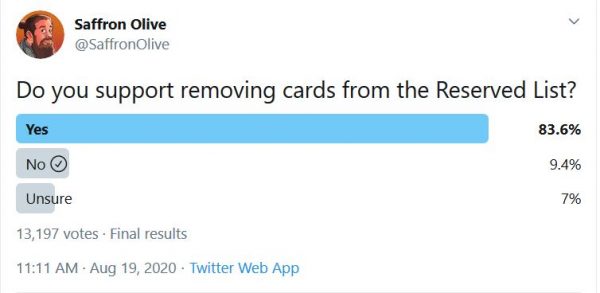
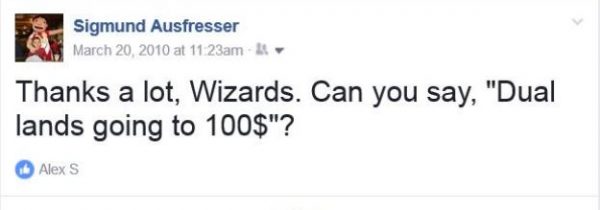
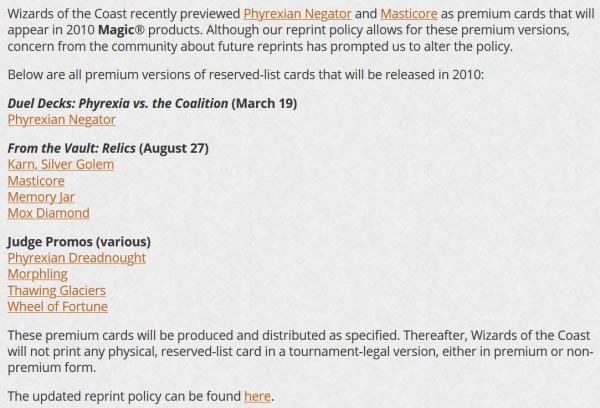
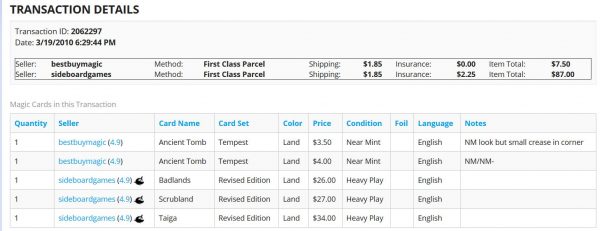
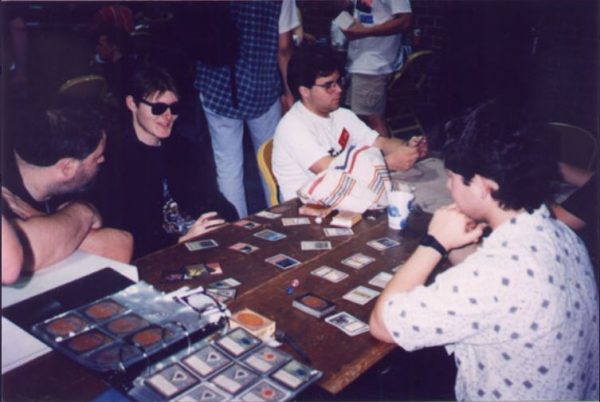
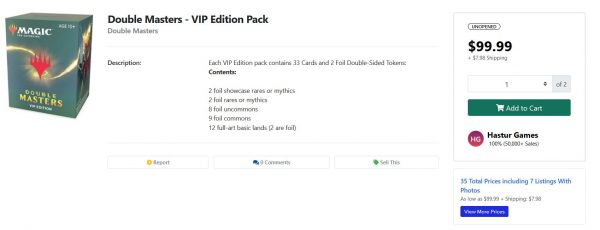



Having been someone who played from the start in 1993 and who missed out totally on $10 duals and $200 Lotuses, I would still unreservedly agree with Sig on this. Killing the RL would kill MTG.
Aspiration and visceral Desirability is still intangibly vital to the appeal of MTG.
I’m reminded of a scene in Monty Python and the Holy Grail:
ARTHUR: Go and tell your master that we have been charged by God with a sacred quest. If he will give us food and shelter for the night he can join us in our quest for the Holy Grail.
GUARD: Well, I’ll ask him, but I don’t think he’ll be very keen. Uh, he’s already got one, you see?
ARTHUR: What?
GALAHAD: He says they’ve already got one!
ARTHUR: Are you sure he’s got one?
GUARD: Oh, yes, it’s very nice!
The scene’s hilarious for a lot of reasons—John Cleese’s over-the-top French accent not the least of them—but the core absurdity is the idea that there’s more than ONE Holy Grail. Like, they just got mass-manufactured and sold at Bed, Bath & Beyond. It’s a ridiculous concept. There’s only ONE Holy Grail. That’s kind of the point. The phrase “Holy Grail” itself has even become synonymous with Unobtainium.
The Reserved List is Magic’s Holy Grail. It’s special, it has value and cachet, and you’re absolutely right that it’s key to Magic’s longevity and collectibility. Dumping the RL would be like mass-producing Holy Grails.
New subscriber here. Thanks for the great article.
As the person responsible for creating the reserve list so many years ago, it’s reassuring to see that at least some wise people like Sig understand why it is and has been so good for Magic. Give the people what they want, even if they don’t know that they want it.
Very well written article. The points that you make are spot on and I hope they continue to carry weight.
How does making legacy unaffordable make it more enjoyable?
How does making Legacy “affordable” make it more enjoyable?
Because then people could actually play it.
I don’t entirely disagree with Sig here, there are valid points regarding the psychology of collecting and market saturation, but he’s only talking about collecting and completely ignoring the game itself as if Magic cards are baseball cards.
Yes, from a collecting only standpoint it’s thrilling to finally get your “white whale”, as it were. But for a player? Someone who isn’t just slabbing cards and keeping them on the shelf or in a vault? It’s a burden and roadblock to the game. If you finally construct your deck and have no one to play with because no one else can afford to or is willing to allocate the expense there, the “enjoyment” quickly drops to zero. Going home early because the event couldn’t fire because nobody else in your community plays Legacy is not “enjoyable”.
There are some straight up flawed arguments in here as well. A 1909S-VDB Lincoln cent is a key date and expensive because it’s rare, true. But as a “game piece”, it’s not needed to participate in the “game” of commerce. You can use a 2015 shield cent instead. At the till, both have the same value and purpose, but somehow that doesn’t diminish the collector’s value of the 1909S. The same would hold if they printed, say, dual lands with new art and frames. The original is still unique and special, and also valuable and harder to obtain. But the game would be playable.
This, exactly this.
From a collectors standpoint the Reserve List makes sense.
BUT THIS IS A GAME!
Being willfully limiting in the ability to print cards that are needed to be competitive in the formats that they are legal in is creating a barrier to play the game.
Also using the example of “key date” coins is exactly refuting the entire premise of the Reserve List. A coin with a “key date” means that it was minted in that year, you can’t mint a 1995 coin in 2020. IF they were to reprint cards, the original “key date” cards would still be sought out by collectors.
People need to play with what they got. It’s part of the game not to have all the cards, and trading for those you need.
Sign is on the mark. Think about who voted in the Twitter poll. The younger, newer players that have only been playing for a few years and do not own any cards from the early era. Hence why they want to abolish the RL so they can own copies of really good cards, cheap.
I get it. But what if you are the older Magic player who has invested time and money into those RL cards? WotC would be completely killing your investment if they turn course on this now. I agree Sig. Keep up the good work.
PS. I picked up a Serras Sanctum a few months back for 85$ ( Slight wear on one corner but still)
“The younger, newer players that have only been playing for a few years and do not own any cards from the early era. Hence why they want to abolish the RL so they can own copies of really good cards”
This is a very disingenuous assumption imo. I have a beta lotus, I have more than two dozen duals including a number of FBB ones (all the loan words), I have my playset of OG Mox Diamonds, and I’ve been playing on and off since somewhere around 2000.
And I voted yes.
Because first and foremost, I want to actually play the game. I can’t play the game if other people aren’t able to own decks. Secondly, it’s not an investment unless you intend to sell, and chances are, unless you’re a game store, you aren’t. And third the idea that all the original versions of RL cards would crash to pennies if new versions were printed is just plain wrong. He brings up coin collecting and mentions that specific years are more expensive because they’re rare. But you know what else they are? Currency – if you need that denomination to participate in commerce, there are other options available, yet the rarity and value of that specific variant holds.
At the very least they need to remove the dual lands – nobody cares if they don’t print cards like Pyramids again, but without duals if this current spike continues Legacy as a paper format will just die.
Thanks for the interesting perspective.
I personally started playing Legacy and even though the decks are more expensive than, say standard, I have to admit that I feel much better about buying Legacy/Reserved list cards than cards that are in standard right now. I like the idea that I can sell the cards again, if need be, for the same price (or more) in a few years. If I were playing standard for a few years and always trying to stay on top, I would likely loose a bunch of money if I wanted to get out. Even just now, I lost much more money on my playsets of Teferi Time Raveler, Oko, Wrenn and Six etc. than on the Volcanic Islands that I bought…
I wonder if a solution could be to allow proxies of, specifically, reserved list cards in official tournaments – and to make all the reserved list cards available online (that already happened in MTGO as far as I know – Maybe Arena could follow if need be). That way, people can still play the game, and collectors who want the original cards can still collect the cards.